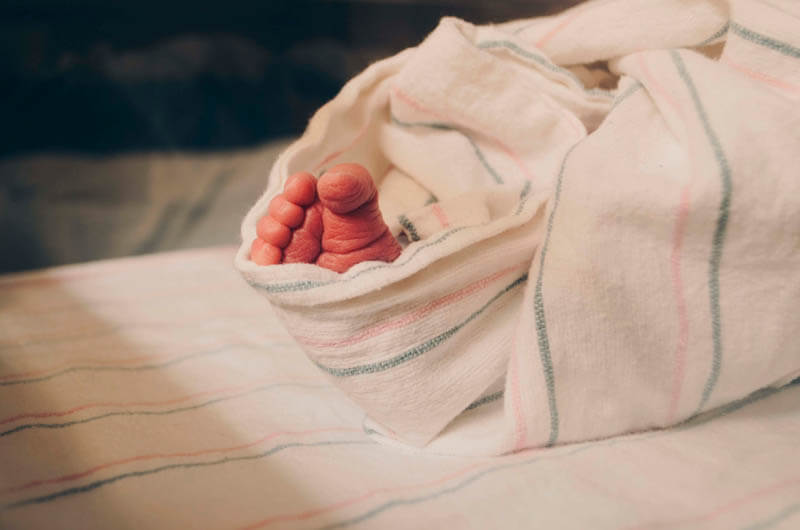To swaddle or not to swaddle? And if yes, then how to swaddle a baby right?
Swaddling a baby may be beneficial for a baby during the first months of their life. And although this method seems quite outdated, most parents use it to help their babies sleep better. So let’s talk about the pros and cons of newborn swaddle, whether it is safe, when it can be used, and how to swaddle a baby.
What Is Swaddling?
Swaddling is a simple technique that is preferred by many moms where you wrap your infant in a swaddle blanket to soothe them and help them sleep better. A baby girl and baby boy swaddle wrap looks like a tiny baby burrito.

Pros and Cons of Swaddling
There are reasons why parents usually choose preemie and newborn swaddle:
- Improve the quality of baby sleep. When they stir, such an enclosed environment helps them to get back to sleep.
- Keep baby warm and cozy. The baby tends to feel more comfortable and secure when swaddled as it resembles that comfy crampedness of the womb.
- Eliminate anxiety. When being swaddled, the baby feels something like being held by mom, which provides a calming and relaxing effect.
- Prevent scratching. The baby’s nails are like the sharpest razors that always travel in the direction of the face. It is common for infants to touch and scratch their faces in their sleep, and often moms find dried blood on the face in the morning. Keeping a baby swaddled prevents face scratching as it keeps arms and hands secure.
- Limit the startle reflex. You may have noticed a baby make jerking motions with their legs and arms in their sleep, thus, waking them up. This is called the Moro reflex. It is involuntary and absolutely normal and goes away at the age of 3-6 months. Swaddling gently presses both legs and arms together limiting those unexpected movements.
- Eliminate blankets. While there are lots of blanket types and they all are extremely pretty and comfortable, they might pose a risk of suffocation if a baby moves around and accidentally gets his face covered with a blanket. Swaddling looks like a better alternative here as it not only prevents this but also provides a safe sleeping position when the baby remains on his back.
- Soothe colic and eliminate crying. The systematic review showed that swaddling decreased excessive crying by 28%, soothed the pain in infants, and overall had a favorable effect on infant behavior.
However, there also exist some concerns which are associated with baby swaddling, and all parents have to be aware of them:
- Risk of developing hip problems and hip dislocation. The position of a swaddled baby makes their knees and hips stay extended to the fullest, thus, creating an unnatural position for them. By keeping the baby in this position, there is a high risk of developing hip dysplasia. A newborn’s hip joint is very sensitive, and additional pressure or positions which cause extension when legs and hips are tightly swaddled can harm it, causing hip dislocation and DDH according to the American Academy of Orthopaedic Surgeons.
- Risk of SIDS when the baby has learned to roll over. When the baby is showing the attempts to roll over, parents have to stop swaddling as a swaddled baby in an on-the-stomach position is at a high risk of suffocation during sleep.
- Risk of overheating. When swaddled with a warm blanket, there is a chance the baby gets overheated. To avoid this, consider light clothing and blankets made from natural materials.
- Sleep problems. When the baby gets swaddled long enough, they may get used to it and develop a habit, something like a crutch to fall asleep. This may make it difficult to get them to sleep without swaddling. On the other hand, swaddling is the reason why babies tend to sleep too much and eat less, thus, not gaining enough weight. And while the success of breastfeeding depends on demand and supply, reduced demand will lead to reduced milk supply, slow weight gain, risk of dehydration, and premature introduction to formula. For moms, it may mean a higher risk of plugged ducts and mastitis.
- Lack of movement, which is undesirable. Healthy development is about moving freely, but when babies restrained, they can’t move and feel their toes and fingers.

How to Swaddle a Baby: Step-by-Step Guide
Step 1.
Put a cotton swaddle blanket on a flat surface, creating a shape of a diamond, folding the top corner. The top point has to stay somewhere near the center of the blanket.
Step 2.
Place the baby and make sure the neck stays above the edge of the top fold.
Step 3.
Take the left side of the swaddle blanket and wrap it over the left arm and chest, tucking it underneath the right arm of the baby and their back, leaving the right arm free.
Step 4.
Fold the bottom corner up over the baby’s body and tuck the blanket under their chin (under the first fold). Slightly straighten the right arm of the baby, pull the right side of the swaddle blanket over the body, and tuck it under the baby’s left side.
Step 5.
The bottom of the swaddle blanket has to be twisted loosely and tucked underneath the baby’s body.
MAKE SURE the swaddle is snug enough but not tight! Check it this way: allow the space of two to three fingers between the baby’s chest and the swaddle blanket.
MAKE SURE the blanket is loose around the hips. Best swaddle for newborn lets the baby stay in a frog-style position and move legs freely.
How to Swaddle a Baby Correctly: Safety Considerations
To ensure your baby gets the most out of swaddling, follow these safety tips:
- Don’t swaddle your infant above the shoulders.
- To reduce the risk of hip problems, choose hip-friendly swaddling techniques and allow some space for the baby to move their knees and hips.
- Use special thin and breathable blankets made from organic materials like cotton and muslin. Large muslins, baby burrito blankets, and swaddle sleeping sacks are what many parents choose.
- ALWAYS put your baby to sleep on the back. Avoid front and side positions because of the high risk of suffocation when the baby accidentally turns into their sleep.
- The best baby swaddle is firm but gentle. Try to avoid tight swaddling. Perhaps, you’ll find a newborn sleep sack an advantage.
- Make sure the baby doesn’t overheat when swaddled. Check the temperature and opt for light clothing.

Swaddling and SIDS
It isn’t still unclear whether swaddling has some effect on sudden infant death syndrome. There has been a decline in deaths because of SIDS. Experts suppose the main reason is that babies are put to sleep on their backs. Swaddling prevents infants from turning to the face-down position, thus, providing protection from SIDS. However, it is safe until babies start practicing roll-overs which can potentially increase the risk of SIDS if swaddled.
FAQ
When to swaddle a newborn?
You may choose to swaddle your infant for a nap, nighttime sleep, or when you want to give them some soothing time if they experience some discomfort, e.g. colic.
For how long to swaddle a baby?
The American Academy of Pediatrics states that swaddling should be stopped as soon as your baby starts showing the attempts to roll over, and this usually happens at age of 2-3 months. So usually parents swaddle their babies for the first 2-3 months of their life.
Is it ok not to swaddle?
Everything is up to you and your baby. If swaddling soothes and comforts your infant, why not? But if your baby hates restricted movements and tries to break free every time you swaddle, you might want to abandon this idea, and it’s absolutely normal. But before giving it up completely, try some alternatives, e.g. a sleep-sack-swaddle hybrid, a zip-up cocoon, or natural position swaddles.
How to swaddle – with arms up or down?
Pediatricians advise swaddling the baby with their arms placed down and to the sides. This is supposed to reduce the chance that they wiggle out. Arms up swaddle is another option of loose swaddle when babies are able to move their hands freely.
How to swaddle with one arm out?
Practically, the process is the same except for you just leave the dominant arm free. It is a perfect introduction to transitioning the baby out of a swaddle.
What about sleep sacks or wearable blankets?
Baby swaddle blankets, muslin blankets, swaddle sacks – everything will do if it is okay for your little muffin. Choose whatever you see is the best swaddle for your baby.
How to reach the balance between swaddling too tight and too loose?
If you swaddle a baby very tight, there is a high risk of compressing the chest which leads to worse breathing and cuts off proper blood circulation. On the other hand, swaddling too loose isn’t good either as it may lead to suffocation if the blanket covers up the baby’s face. Also it may not be effective in soothing the newborn because of the Moro reflex that is often responsible for waking them up from sound sleep.
How to swaddle a baby tight and how tight should a swaddle be?
We don’t advise swaddling the baby tight because there is a high risk of hip dysplasia and joint problems when the baby’s legs stay in an extended position for a long time. Instead, try a loose swaddle.
How to swaddle a fussy baby?
The process doesn’t differ for a fussy baby. You just have to get more patience and spend a bit more time to get your baby swaddled. It may seem challenging and painstaking for the first time but when both you and your infant get accustomed to it, you won’t experience any difficulties. In case your baby isn’t a fan of swaddling and is always trying to wriggle out, try an alternative to regular blankets such as zippers or Velcro tabs swaddle wraps.
All the recommendations and tips listed here are based on the information provided by a range of highly respected institutions, among which are the FDA (Food and Drug Administration), WHO (World Health Organization), and AAP (the American Academy of Pediatrics).





